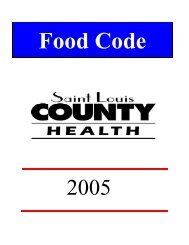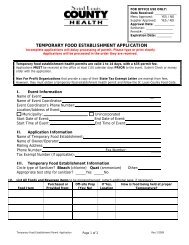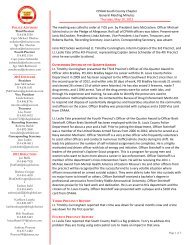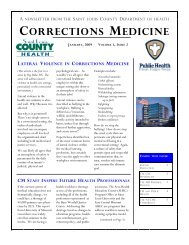Interim Guidelines for Expedited Partner Therapy - St. Louis County
Interim Guidelines for Expedited Partner Therapy - St. Louis County
Interim Guidelines for Expedited Partner Therapy - St. Louis County
Create successful ePaper yourself
Turn your PDF publications into a flip-book with our unique Google optimized e-Paper software.
August 2010<br />
<strong>St</strong>. <strong>Louis</strong> <strong>County</strong> Department of Health <strong>Interim</strong> Health <strong>Guidelines</strong> <strong>for</strong><br />
<strong>Expedited</strong> <strong>Partner</strong> Treatment (EPT) of Sexually Transmitted Diseases<br />
(STDs)<br />
On July 13, 2010, Governor Nixon signed HB 1375, amending RS MO 191 to allow <strong>for</strong><br />
<strong>Expedited</strong> <strong>Partner</strong> Treatment (EPT) <strong>for</strong> sexually transmitted diseases. The revision is<br />
effective on August 28, 2010. This legislation directs the Missouri Department of Health<br />
and Senior Services (MoDHSS) and the Division of Professional Registration within the<br />
Department of Insurance to develop by rule guidance <strong>for</strong> the implementation of EPT.<br />
MoDHSS does not anticipate completing this <strong>for</strong> about a year after the effective date. The<br />
<strong>St</strong>. <strong>Louis</strong> <strong>County</strong> Department of Health is providing this advisory guidance on an interim<br />
basis solely to assist local clinicians in providing EPT <strong>for</strong> appropriate patients and their<br />
partners.<br />
Summary <strong>Guidelines</strong><br />
• Patient’s diagnosis: clinical diagnosis of Chlamydia trachomatis or Neisseria gonorrhoeae<br />
• First‐choice partner management strategy: Attempt to bring partners in <strong>for</strong> complete clinical evaluation, STD<br />
testing, counseling, and treatment.<br />
• Most appropriate patients: those with partners who are unable or unlikely to seek timely clinical services<br />
• Recommended drug regimens (subject to change when CDC releases the 2010 STD Treatment <strong>Guidelines</strong><br />
o Patients diagnosed with chlamydia, but not gonorrhea:<br />
Azithromycin (Zithromax*) 1 gram (250 mg tablets x 4) orally once<br />
o Patients diagnosed with gonorrhea but not chlamydia:<br />
Cefixime (Suprax*) 400 mg orally once, OR cefpodoxime (Vantin*) 400 mg orally once or<br />
cefuroxime (Ceftin*) 1 gram orally once<br />
o Patients diagnosed with both gonorrhea and chlamydia:<br />
Cefixime (Suprax*) 400 mg orally once, OR cefpodoxime (Vantin*) 400 mg orally once or<br />
cefuroxime (Ceftin*) 1 gram orally once PLUS:<br />
Azithromycin (Zithromax*) 1 gram (250 mg tablets x 4) orally once<br />
• Number of doses is limited to the number of known sex partners in previous 60 days (or most recent sex<br />
partner if none in the previous 60 days).<br />
• In<strong>for</strong>mational materials should accompany medication and include clear instructions, warnings, and<br />
referrals.(see attached)<br />
• Patient counseling: abstinence until seven days after treatment and until seven days after partners have<br />
been treated<br />
• Patient re‐testing <strong>for</strong> gonorrhea and chlamydia is recommended <strong>for</strong> three months after treatment.<br />
• Adverse reactions: Missouri’s EPT legislation protects physicians providing EPT from civil liability, except when<br />
the physician “acts negligently, recklessly, in bad faith, or with malicious purpose”. To report adverse<br />
reactions, email EPT@dhss.mo.gov or call 573‐751‐6439.<br />
* Use of trade names is <strong>for</strong> identification only and does not imply endorsement.<br />
<strong>Interim</strong> Guidance <strong>for</strong> EPT Page 1
















